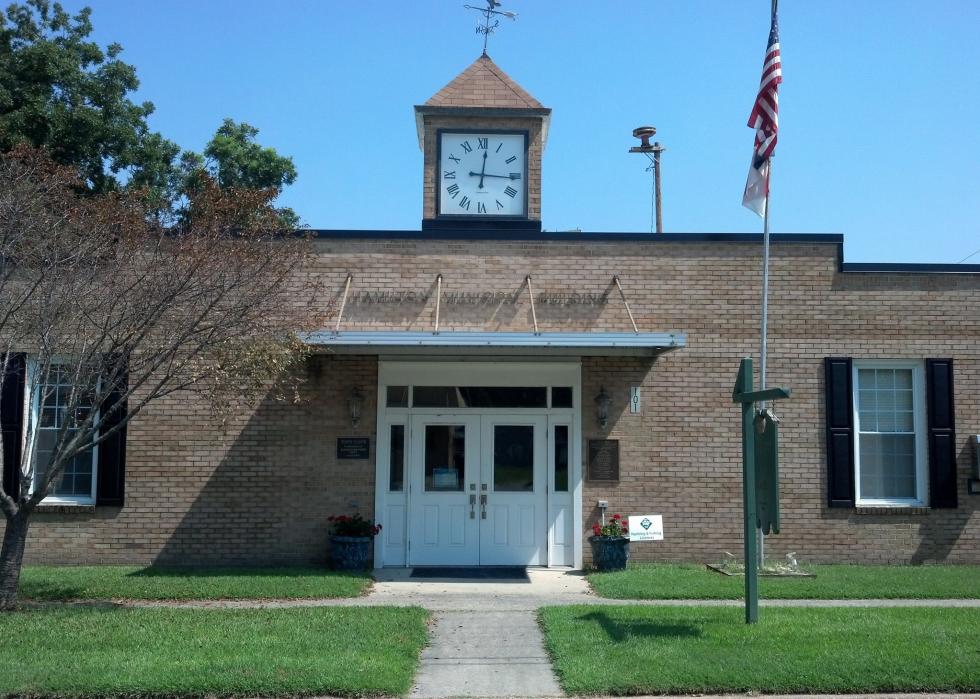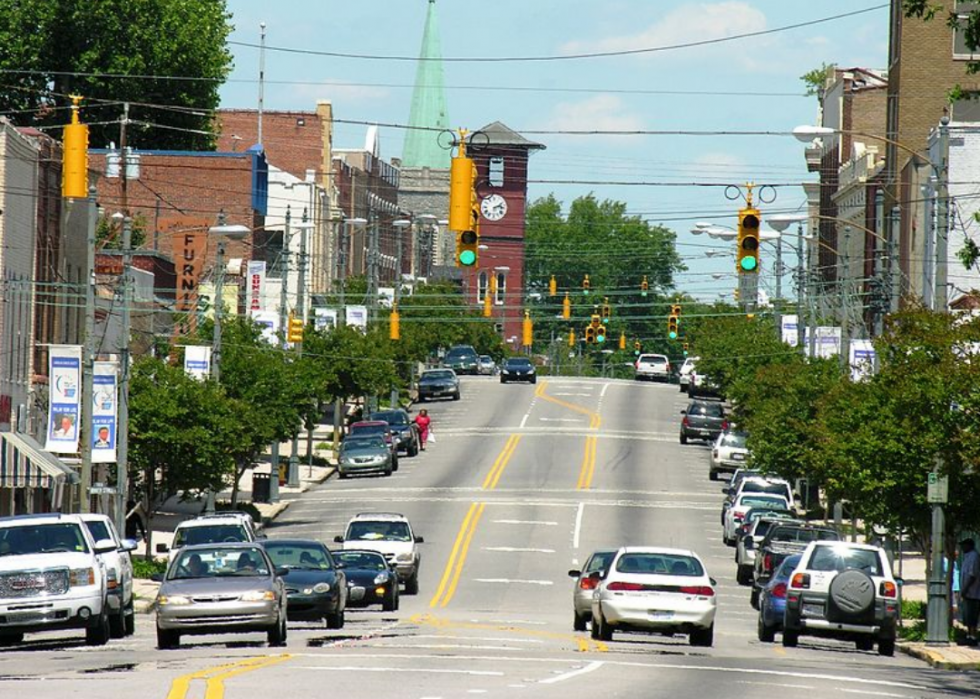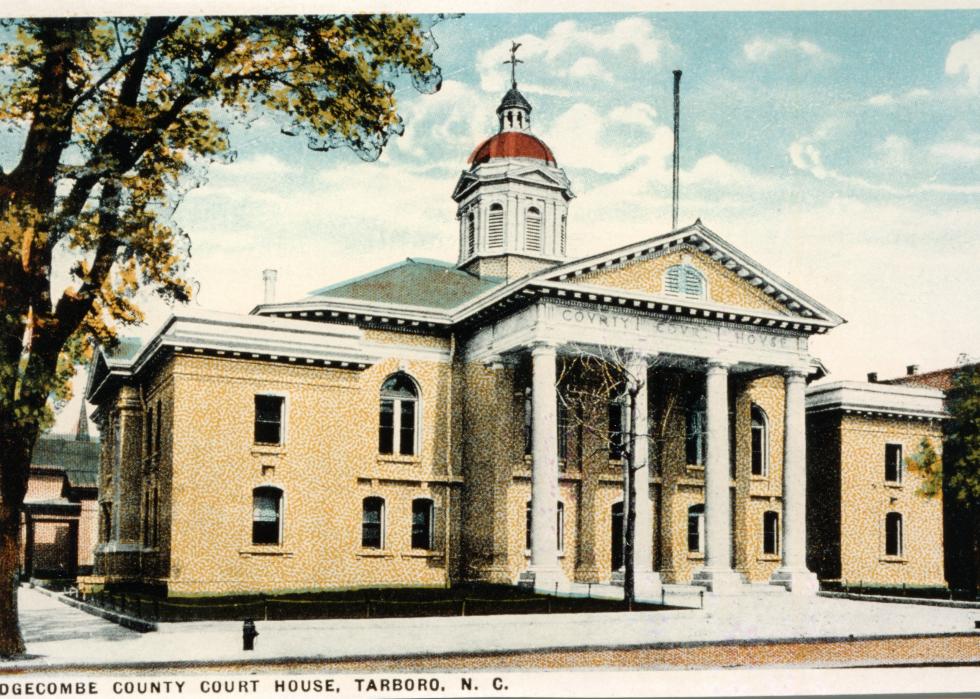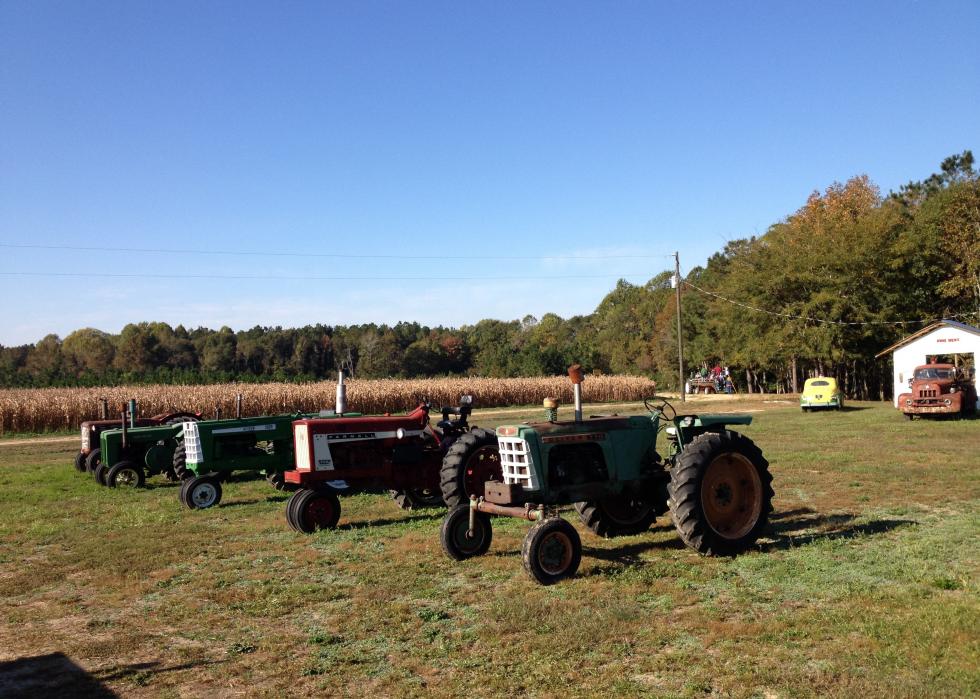Feeding America Household Food Insecurity in North Carolina
Every county in the United States is home to people experiencing food insecurity, defined by the nonprofit Feeding America as "a lack of consistent access to enough food for every person in a household to live an active, healthy life."
The USDA estimates that 89.5% of U.S. households were food secure throughout 2019—that's 116.0 million people. The COVID-19 pandemic put further strain on households already experiencing food hardship, with Feeding America estimating that 42 million people, or 1 in 8 Americans, may experience food insecurity in 2021. This is a slight improvement from 2020 numbers but still represents an enormous burden for millions of children and adults.
Stacker compiled a list of counties in North Carolina with the highest rate of food insecurity using data from Feeding America. Counties are ranked by highest percent of population with food insecurity as of 2019.

1 / 50Canva
#50. Craven County
– Food insecurity rate: 14.9% (15,220 total)
— 36.7% higher than national average
– Child food insecurity rate: 21.2% (4,720 total)
— 45.2% higher than national average
– Annual food budget shortfall: $8,155,000
— Cost per meal: $3.13

2 / 50NatalieMaynor from Jackson, Mississippi, USA // Wikimedia Commons
#49. Caswell County
– Food insecurity rate: 15.0% (3,390 total)
— 37.6% higher than national average
– Child food insecurity rate: 24.3% (1,040 total)
— 66.4% higher than national average
– Annual food budget shortfall: $1,672,000
— Cost per meal: $2.88

3 / 50State Archives of North Carolina Raleigh, NC // Wikimedia Commons
#48. Sampson County
– Food insecurity rate: 15.1% (9,580 total)
— 38.5% higher than national average
– Child food insecurity rate: 22.3% (3,470 total)
— 52.7% higher than national average
– Annual food budget shortfall: $4,642,000
— Cost per meal: $2.83

4 / 50G Keith Hall // Wikimedia Commons
#47. Watauga County
– Food insecurity rate: 15.2% (8,340 total)
— 39.4% higher than national average
– Child food insecurity rate: 16.1% (1,150 total)
— 10.3% higher than national average
– Annual food budget shortfall: $5,410,000
— Cost per meal: $3.79

5 / 50Indy beetle // Wikimedia Commons
#46. Rockingham County
– Food insecurity rate: 15.3% (13,980 total)
— 40.4% higher than national average
– Child food insecurity rate: 21.3% (3,980 total)
— 45.9% higher than national average
– Annual food budget shortfall: $6,990,000
— Cost per meal: $2.92

6 / 50George Dukin // Shutterstock
#45. Clay County
– Food insecurity rate: 15.4% (1,680 total)
— 41.3% higher than national average
– Child food insecurity rate: 20.6% (390 total)
— 41.1% higher than national average
– Annual food budget shortfall: $868,000
— Cost per meal: $3.02

7 / 50Gary Rolband // Shutterstock
#44. Ashe County
– Food insecurity rate: 15.4% (4,140 total)
— 41.3% higher than national average
– Child food insecurity rate: 19.4% (940 total)
— 32.9% higher than national average
– Annual food budget shortfall: $2,065,000
— Cost per meal: $2.92

8 / 50Indy beetle // Wikimedia Commons
#43. Wayne County
– Food insecurity rate: 15.4% (19,010 total)
— 41.3% higher than national average
– Child food insecurity rate: 23.7% (6,980 total)
— 62.3% higher than national average
– Annual food budget shortfall: $9,250,000
— Cost per meal: $2.85

9 / 50Nikola Spasic Photography // Shutterstock
#42. Pitt County
– Food insecurity rate: 15.4% (27,480 total)
— 41.3% higher than national average
– Child food insecurity rate: 21.9% (8,430 total)
— 50.0% higher than national average
– Annual food budget shortfall: $14,130,000
— Cost per meal: $3.01

10 / 50Anya Douglas // Shutterstock
#41. Onslow County
– Food insecurity rate: 15.4% (30,030 total)
— 41.3% higher than national average
– Child food insecurity rate: 19.5% (9,300 total)
— 33.6% higher than national average
– Annual food budget shortfall: $15,272,000
— Cost per meal: $2.97

11 / 50Indy beetle // Wikimedia Commons
#40. Northampton County
– Food insecurity rate: 15.5% (3,080 total)
— 42.2% higher than national average
– Child food insecurity rate: 29.8% (1,060 total)
— 104.1% higher than national average
– Annual food budget shortfall: $1,536,000
— Cost per meal: $2.92

12 / 50Toribio93 // Shutterstock
#39. Madison County
– Food insecurity rate: 15.5% (3,340 total)
— 42.2% higher than national average
– Child food insecurity rate: 17.3% (680 total)
— 18.5% higher than national average
– Annual food budget shortfall: $1,876,000
— Cost per meal: $3.29

13 / 50Upstateherd // Wikimedia Commons
#38. Mitchell County
– Food insecurity rate: 15.6% (2,340 total)
— 43.1% higher than national average
– Child food insecurity rate: 19.2% (540 total)
— 31.5% higher than national average
– Annual food budget shortfall: $1,276,000
— Cost per meal: $3.19

14 / 50Alanteitleman // Wikimedia Commons
#37. Martin County
– Food insecurity rate: 15.6% (3,570 total)
— 43.1% higher than national average
– Child food insecurity rate: 25.9% (1,220 total)
— 77.4% higher than national average
– Annual food budget shortfall: $1,719,000
— Cost per meal: $2.82

15 / 50David Byron Keener // Shutterstock
#36. Beaufort County
– Food insecurity rate: 15.6% (7,350 total)
— 43.1% higher than national average
– Child food insecurity rate: 23.5% (2,250 total)
— 61.0% higher than national average
– Annual food budget shortfall: $3,891,000
— Cost per meal: $3.10

16 / 50CZmarlin — Christopher Ziemnowicz // Wikimedia Commons
#35. Hoke County
– Food insecurity rate: 15.6% (8,420 total)
— 43.1% higher than national average
– Child food insecurity rate: 22.6% (3,370 total)
— 54.8% higher than national average
– Annual food budget shortfall: $4,247,000
— Cost per meal: $2.95

17 / 50Indy beetle // Wikimedia Commons
#34. Duplin County
– Food insecurity rate: 15.6% (9,180 total)
— 43.1% higher than national average
– Child food insecurity rate: 23.5% (3,360 total)
— 61.0% higher than national average
– Annual food budget shortfall: $4,481,000
— Cost per meal: $2.86

18 / 50Nolichuckyjake // Shutterstock
#33. Caldwell County
– Food insecurity rate: 15.6% (12,800 total)
— 43.1% higher than national average
– Child food insecurity rate: 19.4% (3,230 total)
— 32.9% higher than national average
– Annual food budget shortfall: $6,042,000
— Cost per meal: $2.76

19 / 50Theresaperry44 // Wikimedia Commons
#32. Bertie County
– Food insecurity rate: 15.7% (3,040 total)
— 44.0% higher than national average
– Child food insecurity rate: 30.8% (1,040 total)
— 111.0% higher than national average
– Annual food budget shortfall: $1,536,000
— Cost per meal: $2.96

20 / 50Boston Public Library // Wikimedia Commons
#31. Hertford County
– Food insecurity rate: 15.7% (3,760 total)
— 44.0% higher than national average
– Child food insecurity rate: 28.3% (1,290 total)
— 93.8% higher than national average
– Annual food budget shortfall: $1,813,000
— Cost per meal: $2.82

21 / 50JNix // Shutterstock
#30. Macon County
– Food insecurity rate: 15.7% (5,450 total)
— 44.0% higher than national average
– Child food insecurity rate: 20.2% (1,290 total)
— 38.4% higher than national average
– Annual food budget shortfall: $2,783,000
— Cost per meal: $2.99

22 / 50AbeEzekowitz // Wikimedia Commons
#29. Jackson County
– Food insecurity rate: 15.8% (6,800 total)
— 45.0% higher than national average
– Child food insecurity rate: 19.7% (1,420 total)
— 34.9% higher than national average
– Annual food budget shortfall: $3,665,000
— Cost per meal: $3.15

23 / 50G Keith Hall // Wikimedia Commons
#28. Surry County
– Food insecurity rate: 15.9% (11,460 total)
— 45.9% higher than national average
– Child food insecurity rate: 20.1% (3,090 total)
— 37.7% higher than national average
– Annual food budget shortfall: $5,535,000
— Cost per meal: $2.83

24 / 50Ammodramus // Wikimedia Commons
#27. Wilson County
– Food insecurity rate: 15.9% (12,980 total)
— 45.9% higher than national average
– Child food insecurity rate: 25.5% (4,800 total)
— 74.7% higher than national average
– Annual food budget shortfall: $6,155,000
— Cost per meal: $2.77

25 / 50Canva
#26. Avery County
– Food insecurity rate: 16.0% (2,800 total)
— 46.8% higher than national average
– Child food insecurity rate: 19.5% (500 total)
— 33.6% higher than national average
– Annual food budget shortfall: $1,481,000
— Cost per meal: $3.09

26 / 50Canva
#25. Cumberland County
– Food insecurity rate: 16.0% (53,180 total)
— 46.8% higher than national average
– Child food insecurity rate: 23.6% (19,460 total)
— 61.6% higher than national average
– Annual food budget shortfall: $27,302,000
— Cost per meal: $3.00

27 / 50Indy beetle // Wikimedia Commons
#24. Greene County
– Food insecurity rate: 16.1% (3,380 total)
— 47.7% higher than national average
– Child food insecurity rate: 25.1% (1,080 total)
— 71.9% higher than national average
– Annual food budget shortfall: $1,757,000
— Cost per meal: $3.04

28 / 50Upstateherd // Wikimedia Commons
#23. Wilkes County
– Food insecurity rate: 16.3% (11,190 total)
— 49.5% higher than national average
– Child food insecurity rate: 22.1% (3,120 total)
— 51.4% higher than national average
– Annual food budget shortfall: $5,366,000
— Cost per meal: $2.80

29 / 50Shapard Wolf // Wikimedia Commons
#22. Yancey County
– Food insecurity rate: 16.4% (2,910 total)
— 50.5% higher than national average
– Child food insecurity rate: 20.0% (660 total)
— 37.0% higher than national average
– Annual food budget shortfall: $1,605,000
— Cost per meal: $3.23

30 / 50Ron Reiring // Wikimedia Commons
#21. Burke County
– Food insecurity rate: 16.4% (14,770 total)
— 50.5% higher than national average
– Child food insecurity rate: 21.7% (3,690 total)
— 48.6% higher than national average
– Annual food budget shortfall: $7,054,000
— Cost per meal: $2.79

31 / 50OptimumPx // Wikimedia Commons
#20. Cleveland County
– Food insecurity rate: 16.4% (15,920 total)
— 50.5% higher than national average
– Child food insecurity rate: 23.2% (4,970 total)
— 58.9% higher than national average
– Annual food budget shortfall: $7,478,000
— Cost per meal: $2.75

32 / 50RnR // Wikimedia Commons
#19. McDowell County
– Food insecurity rate: 16.5% (7,480 total)
— 51.4% higher than national average
– Child food insecurity rate: 20.4% (1,890 total)
— 39.7% higher than national average
– Annual food budget shortfall: $3,782,000
— Cost per meal: $2.96

33 / 50James R Poston // Shutterstock
#18. Cherokee County
– Food insecurity rate: 16.6% (4,640 total)
— 52.3% higher than national average
– Child food insecurity rate: 22.1% (1,050 total)
— 51.4% higher than national average
– Annual food budget shortfall: $2,388,000
— Cost per meal: $3.01

34 / 50KimWrenn // Wikimedia Commons
#17. Vance County
– Food insecurity rate: 16.6% (7,390 total)
— 52.3% higher than national average
– Child food insecurity rate: 27.3% (2,900 total)
— 87.0% higher than national average
– Annual food budget shortfall: $3,344,000
— Cost per meal: $2.65

35 / 50State Archives of North Carolina // Wikimedia Commons
#16. Edgecombe County
– Food insecurity rate: 16.7% (8,800 total)
— 53.2% higher than national average
– Child food insecurity rate: 29.5% (3,540 total)
— 102.1% higher than national average
– Annual food budget shortfall: $4,384,000
— Cost per meal: $2.91

36 / 50Brian Stansberry // Wikimedia Commons
#15. Swain County
– Food insecurity rate: 16.9% (2,410 total)
— 55.0% higher than national average
– Child food insecurity rate: 22.0% (720 total)
— 50.7% higher than national average
– Annual food budget shortfall: $1,305,000
— Cost per meal: $3.17

37 / 50gerrydincher // Wikimedia Commons
#14. Columbus County
– Food insecurity rate: 17.0% (9,540 total)
— 56.0% higher than national average
– Child food insecurity rate: 26.4% (3,160 total)
— 80.8% higher than national average
– Annual food budget shortfall: $4,577,000
— Cost per meal: $2.81

38 / 50Nolichuckyjake // Shutterstock
#13. Rutherford County
– Food insecurity rate: 17.0% (11,320 total)
— 56.0% higher than national average
– Child food insecurity rate: 22.9% (3,160 total)
— 56.8% higher than national average
– Annual food budget shortfall: $5,302,000
— Cost per meal: $2.74

39 / 50Ymblanter // Wikimedia Commons
#12. Washington County
– Food insecurity rate: 17.1% (2,030 total)
— 56.9% higher than national average
– Child food insecurity rate: 32.2% (780 total)
— 120.5% higher than national average
– Annual food budget shortfall: $1,031,000
— Cost per meal: $2.97

40 / 50ncwetlands.org// Wikimedia Commons
#11. Bladen County
– Food insecurity rate: 17.1% (5,730 total)
— 56.9% higher than national average
– Child food insecurity rate: 25.8% (1,810 total)
— 76.7% higher than national average
– Annual food budget shortfall: $3,013,000
— Cost per meal: $3.08

41 / 50digidreamgrafix // Shutterstock
#10. Graham County
– Food insecurity rate: 17.6% (1,500 total)
— 61.5% higher than national average
– Child food insecurity rate: 22.2% (390 total)
— 52.1% higher than national average
– Annual food budget shortfall: $814,000
— Cost per meal: $3.17

42 / 50Cecouchman // Wikimedia Commons
#9. Halifax County
– Food insecurity rate: 17.6% (9,020 total)
— 61.5% higher than national average
– Child food insecurity rate: 29.5% (3,250 total)
— 102.1% higher than national average
– Annual food budget shortfall: $4,442,000
— Cost per meal: $2.88

43 / 50Indy beetle // Wikimedia Commons
#8. Lenoir County
– Food insecurity rate: 17.7% (10,070 total)
— 62.4% higher than national average
– Child food insecurity rate: 29.1% (3,720 total)
— 99.3% higher than national average
– Annual food budget shortfall: $4,669,000
— Cost per meal: $2.71

44 / 50HarmonyReignPope // Wikimedia Commons
#7. Tyrrell County
– Food insecurity rate: 18.1% (740 total)
— 66.1% higher than national average
– Child food insecurity rate: 31.5% (180 total)
— 115.8% higher than national average
– Annual food budget shortfall: $419,000
— Cost per meal: $3.31

45 / 50Tradewinds // Wikimedia Commons
#6. Jones County
– Food insecurity rate: 18.1% (1,740 total)
— 66.1% higher than national average
– Child food insecurity rate: 27.6% (500 total)
— 89.0% higher than national average
– Annual food budget shortfall: $909,000
— Cost per meal: $3.06

46 / 50Jerrye & Roy Klotz, MD // Wikimedia Commons
#5. Richmond County
– Food insecurity rate: 18.1% (8,170 total)
— 66.1% higher than national average
– Child food insecurity rate: 29.3% (3,000 total)
— 100.7% higher than national average
– Annual food budget shortfall: $3,660,000
— Cost per meal: $2.62

47 / 50Canva
#4. Alleghany County
– Food insecurity rate: 18.5% (2,030 total)
— 69.7% higher than national average
– Child food insecurity rate: 26.8% (510 total)
— 83.6% higher than national average
– Annual food budget shortfall: $983,000
— Cost per meal: $2.83

48 / 50Katangais // Wikimedia Commons
#3. Robeson County
– Food insecurity rate: 19.1% (25,350 total)
— 75.2% higher than national average
– Child food insecurity rate: 27.3% (9,130 total)
— 87.0% higher than national average
– Annual food budget shortfall: $11,454,000
— Cost per meal: $2.64

49 / 50Canva
#2. Hyde County
– Food insecurity rate: 19.2% (1,000 total)
— 76.1% higher than national average
– Child food insecurity rate: 29.1% (320 total)
— 99.3% higher than national average
– Annual food budget shortfall: $556,000
— Cost per meal: $3.25

50 / 50Nyttend // Wikimedia Commons
#1. Scotland County
– Food insecurity rate: 19.7% (6,900 total)
— 80.7% higher than national average
– Child food insecurity rate: 31.4% (2,530 total)
— 115.1% higher than national average
– Annual food budget shortfall: $3,347,000
— Cost per meal: $2.84
Source: https://www.wnct.com/feedingamerica/several-enc-counties-among-highest-for-food-insecurity-in-north-carolina/
0 Response to "Feeding America Household Food Insecurity in North Carolina"
Post a Comment